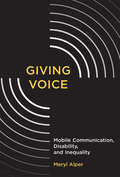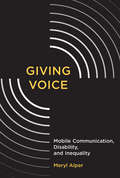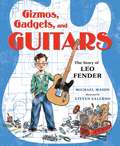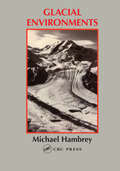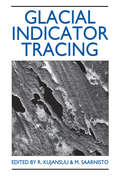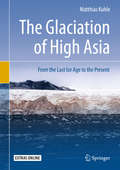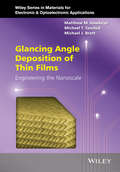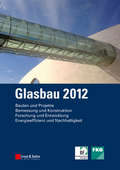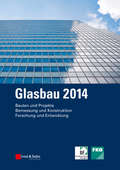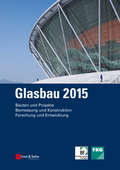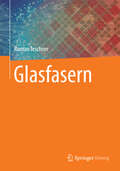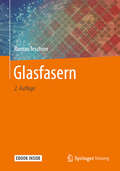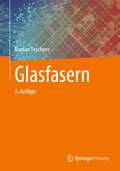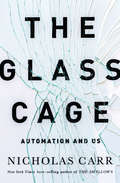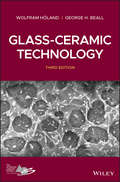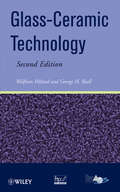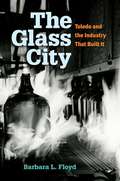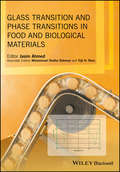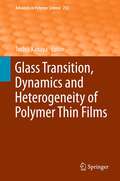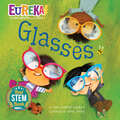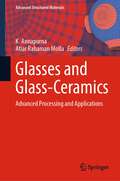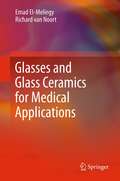- Table View
- List View
Giving Voice: Mobile Communication, Disability, and Inequality
by Meryl AlperMobile technologies are often hailed as a way to "give voice to the voiceless." Behind the praise, though, are beliefs about technology as a gateway to opportunity and voice as a metaphor for agency and self-representation. In Giving Voice, Meryl Alper explores these assumptions by looking closely at one such case -- the use of the Apple iPad and mobile app Proloquo2Go, which converts icons and text into synthetic speech, by children with disabilities (including autism and cerebral palsy) and their families. She finds that despite claims to empowerment, the hardware and software are still subject to disempowering structural inequalities. Views of technology as a great equalizer, she illustrates, rarely account for all the ways that culture, law, policy, and even technology itself can reinforce disparity, particularly for those with disabilities. Alper explores, among other things, alternative understandings of voice, the surprising sociotechnical importance of the iPad case, and convergences and divergences in the lives of parents across class. She shows that working-class and low-income parents understand the app and other communication technologies differently from upper- and middle-class parents, and that the institutional ecosystem reflects a bias toward those more privileged. Handing someone a talking tablet computer does not in itself give that person a voice. Alper finds that the ability to mobilize social, economic, and cultural capital shapes the extent to which individuals can not only speak but be heard.
Giving Voice: Mobile Communication, Disability, and Inequality (Digital Media and Learning)
by Meryl AlperHow communication technologies meant to empower people with speech disorders—to give voice to the voiceless—are still subject to disempowering structural inequalities. Mobile technologies are often hailed as a way to “give voice to the voiceless.” Behind the praise, though, are beliefs about technology as a gateway to opportunity and voice as a metaphor for agency and self-representation. In Giving Voice, Meryl Alper explores these assumptions by looking closely at one such case—the use of the Apple iPad and mobile app Proloquo2Go, which converts icons and text into synthetic speech, by children with disabilities (including autism and cerebral palsy) and their families. She finds that despite claims to empowerment, the hardware and software are still subject to disempowering structural inequalities. Views of technology as a great equalizer, she illustrates, rarely account for all the ways that culture, law, policy, and even technology itself can reinforce disparity, particularly for those with disabilities. Alper explores, among other things, alternative understandings of voice, the surprising sociotechnical importance of the iPad case, and convergences and divergences in the lives of parents across class. She shows that working-class and low-income parents understand the app and other communication technologies differently from upper- and middle-class parents, and that the institutional ecosystem reflects a bias toward those more privileged.Handing someone a talking tablet computer does not in itself give that person a voice. Alper finds that the ability to mobilize social, economic, and cultural capital shapes the extent to which individuals can not only speak but be heard.
Gizmos, Gadgets, and Guitars: The Story of Leo Fender
by Michael MahinThe picture book biography of ingenious American inventor Leo Fender, creator of the world’s most iconic Fender electric guitars. For readers who love Iggy Peck, Architect.Leo Fender loved to thinker and tinker and take things apart and put them back together again. When he lost an eye in a childhood accident, he refused to think of himself as broken. With a new pair of magnifying glasses, Leo got back to doing what he loved, fixing machines big and small—even broken instruments.His inventions—which included the Telecaster and the Stratocaster—would inspire the rock ’n’ roll generation and go on to amplify the talents of legendary guitarists Muddy Waters, Jimi Hendrix, Eric Clapton, and Bonnie Raitt, among others. Fender’s brilliant engineering vision connected science and art forever.Christy Ottaviano Books
Glacial Environments
by Michael HambreyEnhanced by photographic illustrations of extraordinary quality, this text should provide students with a complete introduction to the scientific study of environments dominated by snow and ice. Emphasizing the range of erosional and depositional landforms, drawing on the older geological record, according due attention to the marine environment, and covering all relevant parts of the world - this book should find a wide readership among students of geography, geology and environmental science.; The author has published many research papers and has also been joint-author, co-author or co-editor of six book-length publications.; This book is intended for undergraduate students of glacial environments geomorphology, glaciology/hydrology in departments of geography, environmental sciences and geology.
Glacial Indicator Tracing
by RAIMO KUJANSUU and MATII SAARNISTOThe final report of the 1989 Finnish Work Group 9 of the INQUA on the Genesis and Lithology of Glacial Sediments entitled Glacigenic deposits as indicators of glacial movements and their use for indicator tracing in the search for ore deposits . Emphasizes the significance of extensive application o
The Glaciation of High Asia: From the Last Ice Age to the Present (Earth Sciences In The 21st Century Ser.)
by Matthias KuhleThis book summarizes four decades of glacial-geomorphological field research in Central and High Asia in an attempt to draw a significant link between Quaternary science research and paleoclimatology. Based on the latest geomorphological findings, this study offers a large-scale reconstruction of the Last Glacial Maximum (LGM) that in High Asia encompassed a total expanse of no less than three million km2, including the Central Tibetan plateau with 2.4 million km2. The author offers a complete reconstruction of the Late Glacial, Holocene, and Historical glacier advances as well as the successive Postglacial ablation stages extending to the present. Taken together, the findings presented here provide the first insights into a global-climatic impact of the Last Glacial Maximum in Central and High Asia with respect to the current interglacial stage. The comparative data analyses point to an inland glaciation at subtropical latitude covering an area larger than the Nordic inland glaciation in Greenland. These insights are facilitated by a methodological approach, unprecedented in modern Quaternary research, that combines high-quality panoramic photography with high-resolution satellite imagery. This combination of terrestrial and aerial perspectives enables scientists and readers alike to visualize the geomorphology of the landscape as a three-dimensional space. The author’s successful union of digital big data resources with classical geomorphological analysis offers an exciting new template for future research in Quaternary science and related fields.
Glaciovolcanism on Earth and Mars
by Smellie, John L. and Edwards, Benjamin R. John L. Smellie Benjamin R. EdwardsThe study of volcano-ice interactions, or 'glaciovolcanism', is a field experiencing exponential growth. This comprehensive volume presents a discussion of the distinctive processes and characteristics of glaciovolcanic eruptions, their products, and landforms, with reference to both terrestrial and Mars occurrences. Supported by abundant diagrams and photos from the authors' extensive collections, this book outlines where eruptions have occurred and will occur in the future on Earth, the resulting hazards that are unique to volcano-ice interactions, and how the deposits are used to unravel planetary palaeoclimatic histories. It has a practical focus on lithofacies, glaciovolcanic edifice morphometry and construction, and applications to palaeoenvironmental studies. Providing the first global summary of past and current work, this book also identifies those areas in need of further research, making this an ideal reference for academic researchers and postgraduate students, in the fields of volcanology, glaciology, planetary science and palaeoenvironmental studies.
Glancing Angle Deposition of Thin Films
by Matthew M. Hawkeye Michael J. Brett Michael T. TaschukThis book provides a highly practical treatment of Glancing Angle Deposition (GLAD), a thin film fabrication technology optimized to produce precise nanostructures from a wide range of materials. GLAD provides an elegant method for fabricating arrays of nanoscale helices, chevrons, columns, and other porous thin film architectures using physical vapour deposition processes such as sputtering or evaporation. The book gathers existing procedures, methodologies, and experimental designs into a single, cohesive volume which will be useful both as a ready reference for those in the field and as a definitive guide for those entering it. It covers: Development and description of GLAD techniques for nanostructuring thin films Properties and characterization of nanohelices, nanoposts, and other porous films Design and engineering of optical GLAD films including fabrication and testing, and chiral films Post-deposition processing and integration to optimize film behaviour and structure Deposition systems and requirements for GLAD fabrication A patent survey, extensive relevant literature, and a survey of GLAD's wide range of material properties and diverse applications.
Glasbau 2012
by Silke Tasche Bernhard WellerDieses Buch ist die Fortführung der Sonderheftreihe "Konstruktiver Glasbau" der Zeitschrift Stahlbau, in der seit 2006 jährlich ein Themenheft sehr erfolgreich publiziert wurde. Der zunehmenden Bedeutung des konstruktiven Glasbaus wird mit diesem deutlich umfangreicheren Buch Rechnung getragen. Renommierte Autoren stellen in zahlreichen Fachaufsätzen wegweisende Glaskonstruktionen und innovative Fassadentechnik vor und erläutern die neue DIN 18008 bis hin zum prüffähigen Bemessungsbeispiel. Außerdem werden wichtige Ergebnisse der Forschung präsentiert und neueste Entwicklungen im Bereich energetische Sanierungen dargestellt.
Glasbau 2013
by Silke Tasche Bernhard WellerDas vorliegende Buch beschreibt in zahlreichen Beiträgen namhafter Autoren den aktuellen Stand der Technik im konstruktiven Glasbau. Die Planung und die Ausführung wegweisender Glasarchitektur werden ausführlich erläutert, die Bemessung und die Konstruktion tragender Glasbauteile praxisgerecht erklärt. Die Optimierung zukunftsfähiger Gebäudehüllen wird in gleicher Tiefe behandelt wie die energetische Sanierung denkmalgeschützter Fassaden. Nicht zuletzt vermitteln die jüngsten Ergebnisse anerkannter Forschungseinrichtungen einen zuverlässigen Einblick in die Leistungsfähigkeit des gesamten Glasbaus.
Glasbau 2014
by Bernhard WellerThe design and construction of progressive glass architecture is explained in detail, the design and detailing of load-bearing glass building elements is explained for practical application. The optimisation of futuristic building envelopes is dealt with in the same detail as the energetic refurbishment of listed facades. Not least, the latest results from respected research institutes offer a reliable overview of the potential of glass construction.
Glasbau 2015
by Bernhard Weller Silke TascheThis book is a collection of current and comprehensive papers about buildings and projects, design and construction as well as research and development in the field of structural glass construction.
Glasfasern
by Roman TeschnerDas Buch stellt eine wichtige Datenquelle von physikalisch-chemischen Eigenschaften der Fasergläser, Glasfasern und der für ihre Herstellung eingesetzten Glasrohstoffe und technologischen Prozessparameter dar. Es hilft dem Leser die Eigenschaften der Fasergläser und Glasfasern besser zu verstehen, um sie im Herstellungsprozess und in der Weiterverarbeitung optimal einzusetzen. Die Herstellprozesse der verschiedenen Glasfaserprodukte wurden in einer kompakten Form kurz und verständlich dargestellt. Das Buch kann sowohl den Glasfachleuten, den Compositsspezialisten, die in der Forschung und Entwicklung bzw. in der Produktion tätig sind, als auch Studierenden der Fachbereiche Glaschemie, Glastechnologie und Werkstoffwissenschaften sehr behilflich sein. Das Buch wurde von einem Praktiker geschrieben, der die Faserglasentwicklung und die Glasfaserproduktion sowie Faserziehprozesse über 20 Jahre aktiv begleitet und erforscht hat.
Glasfasern
by Roman TeschnerDas Buch stellt eine wichtige Datenquelle von physikalisch-chemischen Eigenschaften der Fasergläser, Glasfasern und der für ihre Herstellung eingesetzten Glasrohstoffe und technologischen Prozessparameter dar. Es hilft dem Leser die Eigenschaften der Fasergläser und Glasfasern besser zu verstehen, um sie im Herstellungsprozess und in der Weiterverarbeitung optimal einzusetzen. Die Herstellprozesse der verschiedenen Glasfaserprodukte wurden in einer kompakten Form kurz und verständlich dargestellt. Das Buch kann sowohl den Glasfachleuten, den Compositsspezialisten, die in der Forschung und Entwicklung bzw. in der Produktion tätig sind, als auch Studierenden der Fachbereiche Glaschemie, Glastechnologie und Werkstoffwissenschaften sehr behilflich sein. Das Buch wurde von einem Praktiker geschrieben, der die Faserglasentwicklung und die Glasfaserproduktion sowie Faserziehprozesse über 20 Jahre aktiv begleitet und erforscht hat.
Glasfasern
by Roman TeschnerDas Buch stellt eine wichtige Datenquelle von physikalisch-chemischen Eigenschaften der Fasergläser, Glasfasern und der für ihre Herstellung eingesetzten Glasrohstoffe und technologischen Prozessparameter dar. Es hilft dem Leser die Eigenschaften der Fasergläser und Glasfasern besser zu verstehen, um sie im Herstellungsprozess und in der Weiterverarbeitung optimal einzusetzen. Die Herstellprozesse der verschiedenen Glasfaserprodukte wurden in einer kompakten Form kurz und verständlich dargestellt. Das Buch kann sowohl den Glasfachleuten, den Compositsspezialisten, die in der Forschung und Entwicklung bzw. in der Produktion tätig sind, als auch Studierenden der Fachbereiche Glaschemie, Glastechnologie und Werkstoffwissenschaften sehr behilflich sein. Das Buch wurde von einem Praktiker geschrieben, der die Faserglasentwicklung und die Glasfaserproduktion sowie Faserziehprozesse über 20 Jahre aktiv begleitet und erforscht hat. Dr. Teschner ist Autor von zahlreichen Patenten und Fachveröffentlichungen.
The Glass Cage: Automation And Us
by Nicholas CarrAt once a celebration of technology and a warning about its misuse, The Glass Cage will change the way you think about the tools you use every day. In The Glass Cage, best-selling author Nicholas Carr digs behind the headlines about factory robots and self-driving cars, wearable computers and digitized medicine, as he explores the hidden costs of granting software dominion over our work and our leisure. Even as they bring ease to our lives, these programs are stealing something essential from us. Drawing on psychological and neurological studies that underscore how tightly people's happiness and satisfaction are tied to performing hard work in the real world, Carr reveals something we already suspect: shifting our attention to computer screens can leave us disengaged and discontented. From nineteenth-century textile mills to the cockpits of modern jets, from the frozen hunting grounds of Inuit tribes to the sterile landscapes of GPS maps, The Glass Cage explores the impact of automation from a deeply human perspective, examining the personal as well as the economic consequences of our growing dependence on computers. With a characteristic blend of history and philosophy, poetry and science, Carr takes us on a journey from the work and early theory of Adam Smith and Alfred North Whitehead to the latest research into human attention, memory, and happiness, culminating in a moving meditation on how we can use technology to expand the human experience.
Glass-Ceramic Technology
by Wolfram Holand George BeallAn updated edition of the essential guide to the technology of glass-ceramic technology Glass-ceramic materials share many properties with both glass and more traditional crystalline ceramics. The revised third edition of Glass-Ceramic Technology offers a comprehensive and updated guide to the various types of glass-ceramic materials, the methods of development, and the myriad applications for glass-ceramics. Written in an easy-to-use format, the book includes an explanation of the new generation of glass-ceramics. The updated third edition explores glass-ceramics new materials and properties and reviews the expanding regions for applying these materials. The new edition contains current information on glass/glass-ceramic forming in general and explores specific systems, crystallization mechanisms and products such as: ion exchange strengthening of glass-ceramics, glass-ceramics for mobile phones, new glass-ceramics for energy, and new glass-ceramics for optical and architectural application. It also contains a new section on dental materials and twofold controlled crystallization.
Glass Ceramic Technology, 2nd Edition
by Wolfram Holand George H. BeallGlass-ceramic materials share many properties with both glass and more traditional crystalline ceramics. This new edition examines the various types of glass-ceramic materials, the methods of their development, and their countless applications. With expanded sections on biomaterials and highly bioactive products (i.e., Bioglass and related glass ceramics), as well as the newest mechanisms for the development of dental ceramics and theories on the development of nano-scaled glass-ceramics, here is a must-have guide for ceramic and materials engineers, managers, and designers in the ceramic and glass industry.
The Glass City: Toledo And The Industry That Built It
by Barbara Floyd Barbara L. FloydThe headline, “Where Glass is King,” emblazoned Toledo newspapers in early 1888, before factories in the Ohio city had even produced their first piece of glass. After years of struggling to find an industrial base, Toledo had attracted Edward Drummond Libbey and his struggling New England Glass Company to the shores of the Maumee River, and many felt Toledo’s potential as “The Future Great City of the World” would at last be realized. The move was successful—though not on the level some boosters envisioned—and since 1888, Toledo glass factories have employed thousands of workers who created the city’s middle class and developed technical innovations that impacted the glass industry worldwide. But as has occurred in other cities dominated by single industries—from Detroit to Pittsburgh to Youngstown—changes to the industry it built have had a devastating impact on Toledo. Today, 45 percent of all glass is manufactured in China. Well-researched yet accessible, this new book explores how the economic, cultural, and social development of the Glass City intertwined with its namesake industry and examines Toledo’s efforts to reinvent itself amidst the Midwest’s declining manufacturing sector.
Glass Town Wars
by Celia ReesThe thrilling adventure story based on the writings of the Brontë children, by the bestselling author of Witch ChildWhen Tom is in a coma, his friend Milo decides that he can be a guinea pig for a new gaming device - a device that will take him to a troubled world where he meets the the warrior-like Augusta who is fighting to save her kingdom from takeover by her rival. With Tom at her side, she finds extra courage. Slowly but surely, Tom starts to leave his life in London behind as the two of them become ever more embroiled in a world of chaos and tension that encompasses the past, the present and the future.But life in London won't let Tom go so easily. His friends and family gather around him to try and bring him back - as does a girl from school he barely knows, who comes each day to his bedside to read to him from her favourite book, Wuthering Heights.In this wonderful speculative fiction Celia Rees has created a meta-fictional world that will delight readers. This epic story, with Rees's trademark strong female character and romance at its heart, is a compelling action-driven adventure with delightful twists and turns that thrill and surprise right up to the last page.
Glass Transition and Phase Transitions in Food and Biological Materials
by Jasim Ahmed Mohammad Shafiur Rahman Yrjo H. RoosGlass and State Transitions in Food and Biological Materials describes how glass transition has been applied to food micro-structure, food processing, product development, storage studies, packaging development and other areas. This book has been structured so that readers can initially grasp the basic principles and instrumentation, before moving through the various applications. In summary, the book will provide the “missing link” between food science and material science/polymer engineering. This will allow food scientists to better understand the concept and applications of thermal properties.
Glass Transition, Dynamics and Heterogeneity of Polymer Thin Films
by Toshiji KanayaMobility Gradient of Polystyrene in Films Supported on Solid Substrates, by Yoshihisa Fujii, Hiroshi Morita, Atsushi Takahara and Keiji Tanaka Probing Properties of Polymers in Thin Films Via Dewetting, by Günter Reiter Heterogeneous and Aging Dynamics in Single and Stacked Thin Polymer Films, by Koji Fukao, Takehide Terasawa, Kenji Nakamura, Daisuke Tahara Heterogeneous Dynamics of Polymer Thin Films as Studied by Neutron Scattering, by Rintaro Inoue and Toshiji Kanaya
Glasses: Eureka! The Biography of an Idea (Eureka! The Biography of an Idea)
by Lori Haskins HouranWithout glasses, everything can be a blur! Here is a "biography" of glasses, an essential invention that helps people see clearly.Ever since someone first noticed that a jar of water magnified what was behind it, people have worked to improve their vision. Glasses is a fun and informative look at an invention that makes a huge difference in our lives. This STEAM nonfiction title is part of the new Eureka! series, each book focusing on one groundbreaking, world-changing discovery that millions of people use every single day.
Glasses and Glass-Ceramics: Advanced Processing and Applications (Advanced Structured Materials #178)
by K. Annapurna Atiar Rahaman MollaThis book presents various useful processing techniques and applications of glasses and glass-ceramics. It covers various topics such as introduction to glass, its properties, thermodynamics of glass, heat transfer in glass melts, color in glass and advanced characterization techniques to analyze structure of glasses and glass-ceramics along with functional glasses and glass ceramics for advanced applications. This book will be a useful reference for students, researchers, scientists and technologists working in the field of materials science, especially glass.
Glasses and Glass Ceramics for Medical Applications
by Emad El-Meliegy Richard Van NoortGlass ceramics are a special group of materials in which a base glass can be crystallized under carefully controlled conditions, which in turn determine the properties of the material. These materials offer a wide range of physical and mechanical properties combining the distinctive characteristics of sintered ceramics and glasses. This book provides readers with an interest in medical ceramics with the ability to start making their own glasses and glass ceramics, together with an understanding of the various factors that control the final properties of these medical and dental materials. In addition, the authors describe various industrial problems with current, clinically-used medical glass ceramics and discuss appropriate scientific solutions. Glasses and Glass Ceramics for Medical Applications will appeal to a broad audience of biomaterials scientists, ceramists, and bioengineers, particularly those with an interest in orthopedic and dental applications, as well as scientists and engineers involved in the manufacture of glasses, glazes, enamels, and other glass coatings for the medical materials industry. The book will also be of interest to undergraduate and graduate students in materials engineering and dentistry, and is suitable for use in courses on medical and dental materials.
